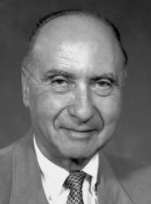Abram Hoffer facts for kids
Quick facts for kids
Abram Hoffer
|
|
|---|---|
 |
|
| Born | November 11, 1917 Sonnenfeld, Saskatchewan, Canada
|
| Died | May 27, 2009 (aged 91) Victoria, British Columbia, Canada
|
| Education | University of Saskatchewan University of Minnesota University of Toronto |
| Known for | Promotion of orthomolecular therapy as a treatment for schizophrenia |
| Scientific career | |
| Fields | Schizophrenia, Nutrition |
| Institutions | Saskatchewan Department of Public Health University of Saskatchewan |
Abram Hoffer (November 11, 1917 – May 27, 2009) was a Canadian scientist. He was a biochemist, a doctor, and a psychiatrist. He is known for his ideas about how nutrition could help treat mental health issues. He believed that large doses of vitamins, especially niacin, could be useful. He also helped discover that niacin could lower high cholesterol. However, many of his ideas about using vitamins for mental illness were not accepted by most doctors.
Contents
About Abram Hoffer
Early Life and Education
Abram Hoffer was born in 1917. His family lived in a small Jewish village called Sonnenfeld in Saskatchewan, Canada. He was the youngest of four children.
He first became interested in farming. He earned two degrees in agricultural chemistry from the University of Saskatchewan. After that, he studied at the University of Minnesota. He also worked on finding out how much niacin was in wheat products.
Hoffer earned his PhD in biochemistry in 1944. He studied vitamins, especially B vitamins, and how they affect the body. Because of his interest in nutrition, he decided to study medicine. He earned his medical degree (MD) in 1949 from the University of Toronto.
Career and New Ideas
After becoming a doctor, Hoffer became very interested in psychiatry. In 1950, he was hired by the Saskatchewan Department of Public Health. His job was to start a research program for mental health.
Hoffer thought that mental illnesses might be linked to body chemistry. He believed that people with schizophrenia might have trouble removing a substance called adrenochrome from their brains. He called this his "adrenochrome hypothesis." He thought that niacin and Vitamin C could help prevent this problem.
In 1967, Hoffer started his own private practice. He also created a journal called Journal of Schizophrenia. Later, it was renamed the Journal of Orthomolecular Medicine. He used this journal to share his ideas about "nutritional psychiatry." He believed that mainstream medical journals often rejected his ideas.
In 1976, Hoffer moved to Victoria, British Columbia. He continued his private practice there until he retired in 2005. He also founded the International Society for Orthomolecular Medicine in 1994. He continued to give advice on nutrition and edited his journal.
Abram Hoffer passed away on May 27, 2009, at the age of 91. He was buried in Victoria, British Columbia.
Hoffer's Research
Niacin and Cholesterol
In the 1950s, while working at the Regina General Hospital, Hoffer and his colleague James Stephen studied niacin. They looked at how large doses of niacin affected different diseases. At the same time, another scientist, Rudolf Altschul, was studying niacin's effect on cholesterol.
The three scientists worked together. In 1955, they published a paper. It showed that high doses of niacin could significantly lower cholesterol levels in people. Other researchers later confirmed these findings. Today, high-dose niacin is still used to help people with high blood cholesterol.
Niacin and Mental Health
Hoffer continued to believe that niacin could help treat schizophrenia. However, this idea was not accepted by most doctors. High doses of niacin can cause side effects, like a strong flushing of the face. Rarely, it can also affect the liver.
Later research suggested that some of Hoffer's ideas about adrenochrome might have some truth. For example, people with schizophrenia sometimes have problems with genes that help remove certain substances from the brain. Even so, other scientists could not always get the same results as Hoffer when trying to treat schizophrenia with niacin.

